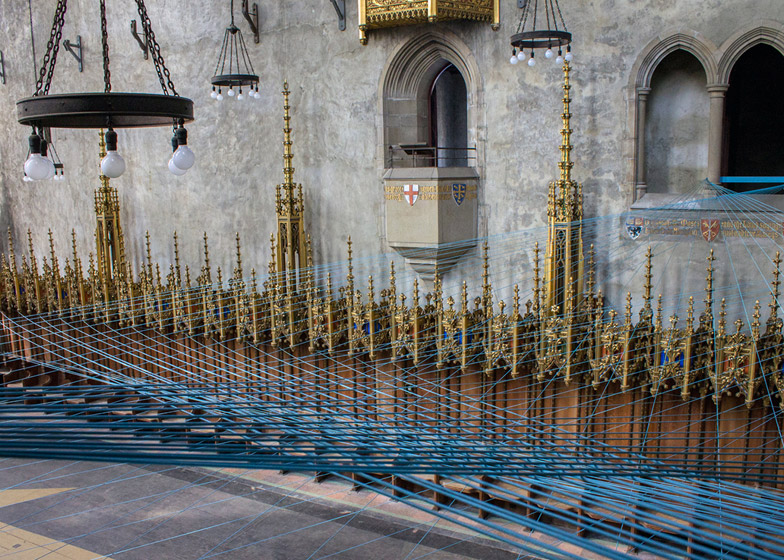Brooklyn-based visual artist Aaron Asis tied over 2,000 metres of blue cord across Philadelphia's disused St Andrew's Collegiate Chapel for this installation (+ slideshow).
The Ci-Lines – pronounced "see-lines" – installation was created by tying and wrapping blue paracord around carved wooden posts and architectural columns within the church.
Resulting lines across the space follow the paths of natural light entering through the windows of the 1924 Gothic Revival-style church, located on the corner of South 42nd Street and Spruce Street in West Philadelphia.
The installation intended to draw attention to the chapel's architecture and engage the local community with the forgotten landmark, which has been closed and without heating, electricity or plumbing for more than 20 years.
"I wanted to showcase St Andrew's own existing architectural grandeur," said Asis. "By using cords to highlight bands of natural light and by creating form amidst the interstitial, I invited visitors into a kind of visual portal through which they could appreciate the detailed grace of this vacant chapel."
The use of tensioned cord was inspired by elements of the building's architecture and fittings, including the vertical lines in the stonework, and seats that were designed to draw the eye up to the painted ceiling.
Asis told Dezeen that the act of connecting existing points in space to each other "serves as a compliment to the majesty of the chapel's interior and represent a form that was inherently understated and always there".
Blue was chosen in response to the subtle use of the colour as an accent within the existing interior. "Both the material and colour choices were very deliberately chosen to reinforce the primary objective of Ci-Lines, which was to attract visitors to the chapel and to encourage their own interaction with the interior," he said.
Visitors were able to view Ci-Lines and explore St Andrew's over three days between 28 February and 14 March 2015.
The event culminated in a panel discussion on the final day, during which speakers were invited to share stories about the chapel's active life.
The installation was created in collaboration with the University City Arts League and students from Penn Alexander School, with support from Philadelphia photographer Lori Waselchuk.
A number of artists and designers have used cord or string to create patterns, paths or coverings in their installations. At a monastery in France, Atelier Yokyok stretched thin blue strings between arch-shaped frames to create tunnels across the cloister garden.
Elsewhere in country, Pier Fabre suspended red lines from the top of a waterfall and over the pool in front.
Photography is by Michael Bixler/Hidden City Philadelphia.






